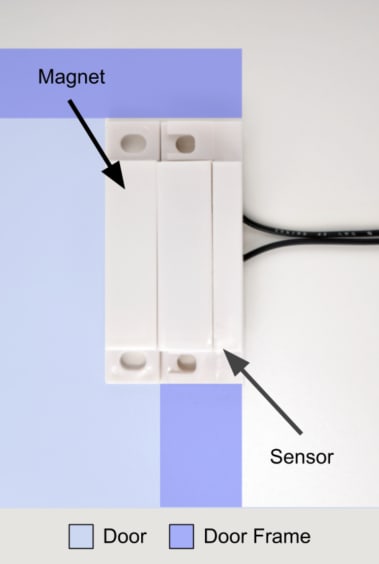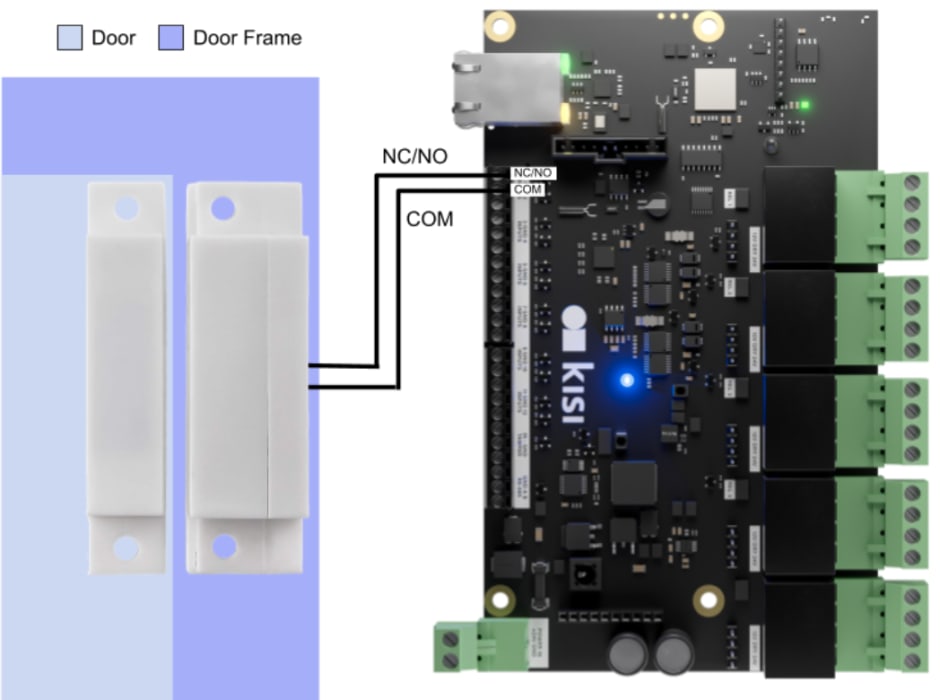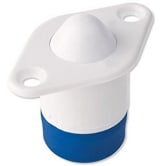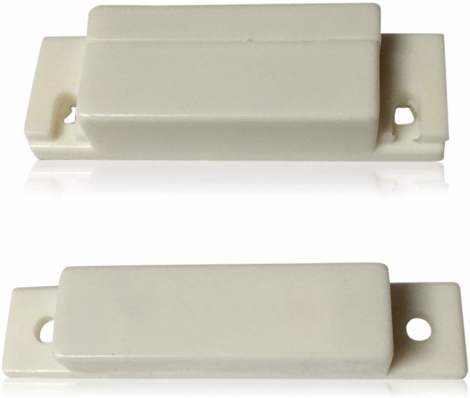What is a door contact sensor? #
A contact sensor can be an important component of access control systems and smart homes. Although the solution was originally designed to detect when intruders opened windows or doors, the device has evolved over the years to offer many more functions. In fact, it often provides the crucial data smart homes need to take intelligent actions. A contact sensor can turn your lights on, trigger a smart door alarm on your smartphone or control a smart thermostat, among other functions.
If you are interested in looking at how contact sensors work for door and window security, check out our dedicated guide.
How does a door contact sensor work? #
A door contact sensor is an important component of access control systems and smart homes. As the name implies, door contact sensors detect if a door, window, or other potential entrance is open or closed. They are composed of two parts – a magnet and a sensor. The magnet is typically installed on the door, while the sensor is fixed on the door jamb or frame. The sensor uses magnetic fields to track movements and signals if the door is open to the security system. While access control is the main function of door contact sensors, they can be integrated as triggers into automation systems and for optimizing energy efficiency.

When a door is opened, the components are separated. The sensor triggers a response or sends a notification to your access control system. Read our dedicated guide on using door contact sensors to trigger alarms when doors or windows are opened without authorization.
Watch the video below for more information on door contact sensors, their benefits, use cases, and installation tips.
The importance of setting door contact sensors in access control #
Adding door contact sensors to your access control system improves security and offers extended functionalities and automation for optimized space utilization. Read on for more details.
1. Alarm activation #
The primary function of door contact sensors is to trigger an alarm when a potential intruder opens a door, window, or other secured object without authorization. For instance, if the contact sensors detect an ‘open’ window or door signals in an armed security system, the alarm is triggered.
These alarms are widely used in commercial and residential buildings, since they often enforce an essential part of the perimeter defense for your facility.
2. Enhanced security with real-time smartphone alerts #
When adding door contact sensors to a modern access control system, you can receive real-time alerts on your smartphone when ‘open’ or ‘closed’ signals are transmitted.
For instance, with Kisi, you can get real-time notifications on your phone or email when a door is forced open. This event is created when Kisi does not detect an unlock, but the contact sensor reports the door being open. You can also define how long the contact sensor should wait to trigger a notification alert that a door is being held open after the user unlocks the door.
With a little more advanced contact sensor circuitry, the Kisi controller can also detect wiring malfunctions, like cut and shorted wiring, by measuring the voltage.
3. Integrations for automated actions #
In addition to activating and transmitting alerts, contact sensors can automatically trigger or activate various devices on the same security or smart building system. The sensors feed real-time data into the system to activate other connected devices.
For instance, you can connect your modern access control solution with your lighting system to not only manage if the lights are turned on when the person enters the room but also set specific lighting and shade preferences for a specific Kisi user that enters the door.
You can also use door contact sensors to optimize energy efficiency. The sensor can communicate with the thermostat to adjust the heating or cooling if you leave a window or door open, optimizing your energy use.
4. Data analytics for improved efficiency #
Wiring door contact sensors to your access system enables you to collect valuable data for purposes of analysis and decision-making. They can help you to gain insights into occupancy patterns by collecting data on the flow of people in and out of different offices or rooms for analysis.
Identify which areas your employees use the most and at what times of day, so that you can optimize your space allocation. You can plan to expand the overcrowded areas or repurpose the underutilized ones. You can also reduce unnecessary overhead costs for maintaining unused or underused facilities, saving on utilities such as heating, cooling, and cleaning.
You can also optimize your spaces’ security by analyzing access patterns. Investigate if there are unauthorized or unusual access events in a certain area or during a particular time of day. Expand your security system accordingly by adding extra door readers or integrating cameras to prevent potential security breaches.
Installing a door contact sensor for access control #
Be sure to unplug the controller before wiring anything. To wire your door contact sensor with Kisi, you need:
- Kisi Controller Pro 2
- Door contact sensor
- Wires
- Flathead screwdriver
Hardware setup: Wiring the door contact sensor #
- Unplug the Kisi controller before wiring.
- Identify the general inputs located on the left side of the controller. Note: Two IN (Input) pins share one GND (Ground): IN1, GND, IN2, GND, IN3, etc.
- Wire the GND (Ground) pin of the controller to the negative or COM (Common) wire of the contact sensor.
- Wire the IN (Input) pin of the controller to the positive or NC/NO (Normally Closed/Normally Opened) wire of the contact sensor.
- Verify that all connections are secure and that there are no loose wires.

Software: Setting up the door contact sensor #
- Go to web.kisi.io.
- Click on ‘Places’ and select your place.
- Click on ‘Hardware’, ‘Controllers’, and select the controller the door contact sensor is wired to.
- Scroll down to ‘Inputs’ and select the input number the door contact sensor is wired to.
- Click on ‘Type’ and select ‘Contact Sensor’.
- On ‘Search Door’, type the name of the door the contact sensor is mounted to.
- Under ‘Duration’, define how long the contact sensor should wait after an Unlock event before triggering a ‘Held open’ event.
- Under ‘End of Line Type’ section, specify the desired end-of-line status that you want Kisi to detect. ‘Cut detect’: Detects if the wiring is cut. ‘Short detect’: Detects if the wiring is shorted. ‘Cut and short detect’: Detects both cut and shorted wiring scenarios.
- Enable the toggle.
- Click ‘Save’.
Door contact sensor types #
Door contact sensors are wired or wireless. In the following paragraphs, we’ll explore the different types of wired and wireless contact sensors for doors and windows.
Overhead door contact sensors #
Featuring armored cables linked to the switch to withstand more wear, overhead door contacts are most often used on large roll-up garage doors. Garage doors need wide gap contact sensors since they typically do not have proper signaling when closed. Otherwise, they are prone to false alarms.

Roller ball door contact sensors #
Typically installed on door jams on the hinge side, roller ball door contacts are recessed. However, they feature ball protrusions after installation. The contact closes when doors are closed and opens when the reverse is true, triggering the alarm.

Surface mount door contact sensors #
Wired connections are used to link the contact to the control panel. Although it can be used as a wireless contact sensor, surface mount door contacts are becoming more and more outdated with the increased popularity of wireless home security systems.

Pull-apart contact sensors #
Pull-apart contact sensors consist of a hole and a magnet. The magnet slides into the hole to complete the circuit. If a door is opened and the system is armed, the contact opens and triggers the alarm. Pull-apart contact sensors are often used as solutions for gates.

Recessed door contact sensors #
The connections of recessed door contact sensors are soldered so the wire can move easily into the hole to make contact. These sensors are used with wireless home security or alarm systems and are usually installed inside windows or doors.

Conclusion #
With advantages ranging from increased security to optimized space utilization, commercial spaces can greatly benefit by connecting door contact sensors to access control systems.
A few factors are important to consider regarding your contact sensors, such as choosing the right type of door contact sensor to install on the specific door or window type. You also need to arm the alarm system for contact sensors to work.
Contact our team for a modern access solution or tailored migration options to help you upgrade your access control solution, while keeping most of your existing hardware.

